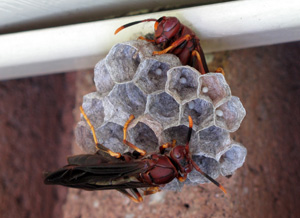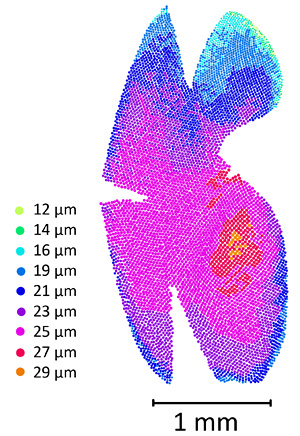Among wasps, bigger eyes evolved the better to see social cues
Some paper wasps have variable facial patterns recognized by their sister wasps. Postdoc Michael Sheehan has now shown that these wasps developed better vision in order to read these social cues.

April 29, 2014
Some wasps have developed bigger eyes, and thus better vision, to read the social cues written on the faces of their sister wasps, according to a new UC Berkeley study.
“The Big Bad Wolf had it right,” said lead author Michael Sheehan, a UC Berkeley postdoctoral fellow. “When Little Red Riding Hood said, ‘Goodness, what big eyes you have,’ he replied, ‘The better to see you with.'”
For some paper wasps, Sheehan said, “We found convincing evidence that the wasps evolved better vision for the purpose of telling one another apart. This is consistent with the idea that hearing, smelling, seeing or other sensory capabilities in animals, including humans, may have evolved in response to communication signals like we see in the wasp.”
Sheehan, a member of UC Berkeley’s Museum of Vertebrate Zoology, and University of Michigan biologists Elizabeth Tibbetts and Judy Jinn published their findings this week in the journal Biology Letters, a publication of Britain’s Royal Society. Jinn is now a graduate student in UC Berkeley’s psychology department.

Two queens of the North American paper wasp Polistes annularis cooperate when building a paper nest, though they do not have variable facial patterns. Michael Sheehan photo.
Biologists have generally assumed that senses such as vision and hearing evolved to improve hunting success or survival, but were not affected by social interactions. Sheehan discovered instead that some paper wasps – those that have variable facial patterns recognized by other wasps in the nest – have more acute vision relative to size than do wasps without variable facial patterns.
“Larger facets in their compound eyes mean better vision, but we found that as these wasps get smaller, they have larger than expected eyes,” he said. “This demonstrates that they evolved improved acuity relative to size in order to discriminate among different individuals in the colony.”
The paper wasps with variable facial patterns are mostly species in which several queens sometimes cooperate to establish a colony, which would make the ability to discriminate among individuals important, he said. Depending on the species, wasps have evolved facial markings that act either like name tags for individual recognition, or like karate belts indicating a queen’s strength.
“This doesn’t overturn evolutionary dogma, but extends the idea that feedback from the environment – in this case, communication signals among members of the same species – can drive change in our senses,” he said.
Natural selection favors sharper vision
Paper wasps are distributed around the globe and known for their open, honey-combed paper nests, made from chewed wood and attached by a stalk to trees and buildings. Like all insects, they have compound or faceted eyes, each a cluster of thousands of small, telescope-like omatidia with an outer lens that focuses light onto sensory cells inside the eye.

A map of the right eye of a wasp (Polistes bahamensis of the Caribbean and southern Florida) showing the size of the facets in the compound eye. A patch at right (orange and red) contains larger facets, providing better frontal vision. Judy Jinn image.
Compound eyes are great for detecting motion – hence a fly’s ability to dodge a swatter – but provide poor resolution, though larger diameter lenses collect more light and generally provide sharper vision. Many flying insects have a high-acuity zone within the compound eye outfitted with larger diameter lenses and typically facing forward.
Tibbetts, associate professor of ecology and evolutionary biology, and Sheehan discovered three years ago that some paper wasps learn and recognize the colorful facial patterns of other wasps in the colony, just as humans recognize others’ faces. Sheehan reasoned that if patterns on the face were important for wasp social interactions, then natural selection might favor wasps that see better, and the lenses in the high-acuity zone on smaller species would be disproportionately larger.
That is what he found when surveying 19 different species of paper wasp (Polistes), half caught in fields around the East and Midwest, and half obtained from museum collections, some of which were more than 100 years old. While the largest lenses on the eyes of big wasps were the same size whether or not the wasps could recognize facial patterns, smaller wasps differed. Those with variable facial patterns had larger lenses in their acute zone than those that do not have variable faces.
Sheehan, who as a behavioral ecologist investigates how social interactions in animals affect behavior, evolution and cognition, plans further studies to see if these wasps evolve larger patterns, essentially creating a larger billboard, and how the visual abilities of wasps have shaped the evolution of the color patterns well.
The work was supported by a grant from the National Science Foundation (IOS-1146139).
RELATED INFORMATION
- Coevolution of visual signals and eye morphology in Polistes paper wasps (April 2014 Biology Letters)
- Insects Recognize Faces Using Processing Mechanism Similar to That of Humans (March 2014 Scientific American article by Tibbetts & Dyer)
- Like humans, the paper wasp has a special talent for learning faces (12/1/11 Univ. of Michigan press release)
- Michael Sheehan’s web site